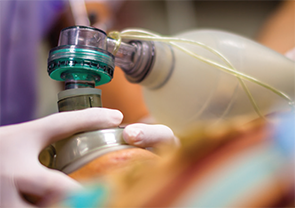Constant advances in technology have allowed for increased ease in performing office-based procedures. In addition, the fact that many surgical techniques can now be done under topical or local anesthetia with or without sedation makes them more suitable to a clinical environment.
Explore This Issue
August 2015Performing certain procedures in an otolaryngology office as opposed to an in-hospital setting can have many advantages, such as cost savings, ease of scheduling, and more efficient use of physician and patient time.
Nonetheless, otolaryngologists need to keep in mind that adverse events are a very real risk of in-office treatments and can catch the surgeon and support staff off guard. In-office adverse events are difficult to track and are not likely reported unless they occurred as part of a published paper. A 2013 review summarized six papers on in-office laryngology procedures and showed that the overall adverse event rate is low (Otolaryngol Clin North Am. 2013;46:63-74).
But Farhad Sigari, MD, an otolaryngologist at Del Rey ENT Associates in Marina Del Rey, Calif., said that as more surgeons transition to in-office therapies, the overall occurrence of in-office adverse events will likely increase. “As done in the hospital setting, it will be important to track and report adverse events so that quality assurance methodologies can be applied to minimize future occurrences,” he said.
The most troubling events are those that can lead to airway compromise, added Dr. Sigari, who notes that vasovagal responses are very common in all otolaryngology procedures when a patient is awake. Excessive bleeding or edema can restrict the airway, and foreign bodies can become dislodged in the airway.
According to John M. DelGaudio, MD, chief of rhinology and sinus surgery and director of Emory University School of Medicine’s Sinus, Nasal, and Allergy Center in Atlanta, each subspecialty procedure entails different potential complications. The most common rhinology complication is epistaxis. He singles out laryngology as the otolaryngology focus with the most serious potential complications, because manipulation of the airway can result in edema and airway obstruction.
 Physicians need to be very aware of their own limits and be willing to abort a procedure before it progresses on a downward spiral toward an adverse event. —Farhad Sigari, MD
Physicians need to be very aware of their own limits and be willing to abort a procedure before it progresses on a downward spiral toward an adverse event. —Farhad Sigari, MDWith regard to laryngology procedures specifically, laryngospasm may result from excessive laryngeal stimulation without adequate topical anesthesia. “This complication could result in acute airway obstruction that will often respond to positive pressure ventilation or topical lidocaine,” said James J. Daniero, MD, MS, assistant professor in the division of otolaryngology at the University of Virginia in Charlottesville. In more severe cases, however, it is necessary to use neuromuscular paralysis and endotracheal intubation. “Fortunately, this is excessively rare in unsedated patients,” he said, “and rarely is airway obstruction due to edema or hematoma formation, but this risk still remains.”
The procedures with the highest risk of airway compromise among laryngeal office-based procedures are vocal fold biopsy, vocal fold injection, transnasal laser ablation of the vocal folds, and transnasal esophagoscopy, because they are the most stimulating to both the patient and laryngeal tissues, Dr. Daniero said. The overall complication rate is extremely low, however.
Pharmacology-related emergencies can also occur. “Allergic reactions to topical or locally injected medication, an improper mixture of lidocaine or epinephrine, or interactions with a patient’s home medications can lead to serious consequences,” Dr. Sigari said. Given all of this, a surgeon should keep in mind that the same adverse events that occur in the operative theater, such as an electrocautery-related fire or burns, wrong surgery site, and inadvertent injury to non-involved limbs or other body parts, could occur in office—even if the chance is rare.
Changes in heart rate and blood pressure during a procedure can increase a patient’s risk of a cardiovascular event, such as MI or stroke, Dr. Daniero added. The fluctuations in heart rate and blood pressure are nearly identical to those that occur upon induction of general anesthesia (Laryngoscope. 2012;122:1331-1334; Ann Otol Rhinol Laryngol. 2012;121:714-718).
Melin Tan-Geller, MD, a laryngologist at Montefiore Health System in Bronx, N.Y., pointed out that something as simple as a patient fainting can be an adverse event. “Making patients comfortable enough to undergo a procedure while they are awake and aware can be challenging as well,” she said. “Patients must be able to sit still for the duration of the procedure and remain calm.” Patients may need to be coached through a procedure to make them as comfortable as possible.
In addition, because local anesthetics are the primary source for patient comfort, take care to avoid toxicity, which could manifest in cardiac events.
Evaluating Risk Level
Proper patient selection and risk stratification is the single most effective method to avoid adverse events in a clinic. This process includes reviewing a patient’s medical history before scheduling him or her for an in-office procedure. “Screen individuals with significant comorbidities or anxiety regarding procedural intervention, as well as patients with abnormal anatomy or a high body-mass index,” Dr. Sigari said. Keep in mind that candidates for in-office procedures might not have been seen or cleared by a primary physician and could therefore be at risk for an undiagnosed or under-managed comorbidity.
 Clarification of specific roles may be the most important part of handling an emergency situation and can begin during a mock critical event. —James J. Daniero, MD, MS
Clarification of specific roles may be the most important part of handling an emergency situation and can begin during a mock critical event. —James J. Daniero, MD, MSDr. Daniero pointed out that a patient who cannot tolerate a diagnostic flexible laryngoscopy will likely have difficulty with any unsedated procedure. “The hemodynamic changes in this setting would likely be more extreme and place the patient at higher risk,” he said. Furthermore, patients with significant cardiac disease may be managed in the controlled setting of the operating room with the help of an anesthesiologist, rather than in the clinic with limited acute care options. Taking a pre-procedure set of vital signs and/or using continuous monitoring can help screen patients who may not be safe to undergo a procedure at the time. Following this procedure can help the physician identify an undiagnosed, poorly controlled hypertensive patient.
Dr. Tan-Geller noted that patients who have a coagulopathy or are taking blood-thinning medications will be more prone to uncontrollable bleeding and may not make good candidates for in-office procedures, because bleeding may be more difficult to control in an office setting, depending upon the available equipment.
Taking Precautions
The manner in which a therapy is delivered in office to an awake patient is quite different that that used in a hospital setting. “Physicians wishing to transition therapies to an in-office setting should seek the advice [of] or shadow another physician who has already performed these procedures in-office,” Dr. Sigari said. “Physicians need to be very aware of their own limits and be willing to abort a procedure before it progresses on a downward spiral toward an adverse event.”
To better ensure a seamless procedure, Dr. Sigari insists on having the proper equipment on hand. “Although one of the goals of an in-office procedure is to reduce cost, the upfront equipment cost can be significant,” he said. “But having the proper equipment to perform a procedure will allow you to complete it quickly and safely.” This might require more scopes, surgical instrumentation, and monitors. Additionally, consider purchasing patient monitoring equipment, such as pulse oximetry devices, heart rate monitors, and blood pressure monitors.
If oral or intravenous sedation is used, it is necessary to monitor oxygen saturation and heart rate, Dr. DelGaudio added.
For laryngeal procedures, adequate topical anesthetic—usually lidocaine or pontocaine—and various methods to deliver the medication to the involved procedure site can reduce the likelihood of laryngospasm, Dr. Daniero said. Associated equipment might include a flexible drip catheter, Abraham cannula, or nebulizer.
Dealing with Adverse Events
Although proper safety equipment is mandated in a hospital or ambulatory surgery center, there are no mandates for minimal equipment in an office setting. Physicians who wish to perform office procedures should have a crash cart on the premises, including a resuscitation cart for cardiopulmonary resuscitation, in the unlikely event of a severe airway or cardiac emergency. Consider partnering with a local hospital or ambulatory surgery center to develop a cart equipped with technologies that can be used to handle basic emergencies. All clinic staff should know where equipment and emergency medications are located. Maintain the cart and its contents, and routinely check inventory for expired or missing medications.
A bag-mask ventilation kit with supplemental oxygen nearby, intubation kit, intravenous access kit, suctioning supplies, cauterization equipment, and medical code supplies are critical to ensure safety during laryngeal office-based procedures.
Dr. Daniero’s clinic runs a mock airway emergency every six months to identify any process, equipment, or medication issues that could complicate a true emergency. “Clarification of specific roles may be the most important part of handling an emergency situation and can begin during this mock critical event,” he said.
A signal that alerts the clinic of an emergency, either in each room or at the nursing station, is beneficial. “This allows the clinician to call for help rapidly, without leaving the patient,” Dr. Daniero said.
The bottom line is to keep in mind that although adverse events are rare when performing certain surgical procedures in an otolaryngology office, a surgeon and his or her staff need to be prepared for any event that could occur. Assess a patient’s surgical risk, and be sure to have the proper equipment and protocols in place for any emergency that might occur.
Karen Appold is a freelance medical writer based in Pennsylvania.
 Crash cart with emergency medications, including epinephrine, diphenhydramine, and steroids
Crash cart with emergency medications, including epinephrine, diphenhydramine, and steroids